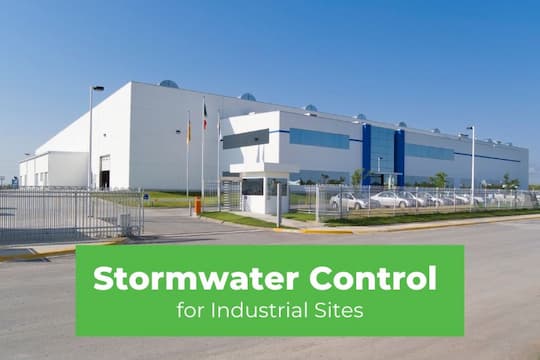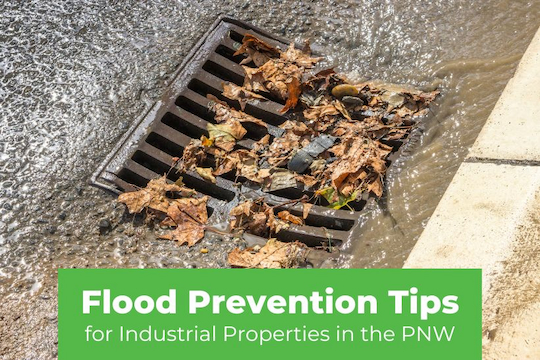In a perfect world, every commercial building would have EPA-recommended green roofs, permeable pavement, and vegetated filter strips. However, the reality of managing stormwater runoff at your commercial properties looks different. Our team has put together five effective strategies for managing stormwater in commercial buildings.
1. Catch Basin Cleaning

Catch basins, or storm drains, are crucial components of any commercial building's stormwater management system. They collect and direct surface water runoff, prevent flooding and manage water flow. Over time, however, sediment, leaves, dirt, and trash accumulate in these basins, reducing their effectiveness.
Catch basin cleaning ensures that stormwater flows freely through the system. Allowing water to drain quickly reduces the risk of surface flooding during heavy rains. It is best not to wait until the first raindrops fall. Per the Washington State Department of Ecology, catch basins are required to be cleaned annually. More frequent cleanings may be recommended in areas prone to heavy rainfall or excess sediment accumulation.
2. Camera Scope Inspections
Camera scope inspections involve using a high-resolution camera mounted on a flexible cable to visually inspect the inside of your property's stormwater pipes, drains, and other related infrastructure. Equipped with LEDs, the camera is fed through the conveyance lines, capturing clear images or video of the interior. At the surface, an inspector will see real-time results via live video footage on a monitor.
The benefits of video pipe inspections in stormwater management include:
- Identification of the exact nature and location of any problems.
- Resources can be focused where they are most needed.
- Problem areas of sediment buildup or root intrusion can be identified.
- It aids in recognizing signs of corrosion, a precursor to pipe leaks or collapses.
3. Pipe Jetting

Your stormwater management efforts largely depend on the unobstructed functioning of conveyance lines. In addition to other recommended maintenance, annual pipe jetting should be considered. In this process, water is forced through a specialized nozzle at very high pressure to clean the inside of stormwater pipes. It washes away debris, sediment, and anything else accumulating to cause blockages or reduce the pipe's capacity.
Effective strategies for managing stormwater in commercial buildings identify three types of pipe jetting.
- Routine maintenance. Regularly scheduled pipe jetting keeps stormwater systems in excellent condition, especially if your property has high debris loads or frequent rainfall.
- Flood prevention. In preparation for storm seasons, pipe jetting ensures that stormwater pipes are clear and capable of handling large volumes of water. Consider adding it to your maintenance schedule.
- Post-storm cleaning. After storms, pipe jetting clears debris that washes into the system. It also maintains proper drainage, preventing future blockages.
This process is non-invasive and environmentally friendly. It relies solely on water and pressure, without the need for chemicals. Moreover, regular jetting saves money in the long run by preventing emergency repairs and reducing the likelihood of flooding-related damage.
4. Storm Filter System Cleaning
Drainage systems that prevent water from flooding parking lots or adding to water pollution require well-functioning storm filters. Storm filters are essential components of stormwater management for many commercial properties. Regular cleaning and maintenance are crucial to ensure their effectiveness and longevity.
Storm filters use replaceable filter media to capture and remove pollutants such as sediment, oils, heavy metals, and nutrients from stormwater runoff. These systems comply with environmental regulations and reduce the impact of urban runoff on natural water bodies.
The system's makeup is straightforward: an inlet, filter cartridges, an outlet, and a sediment sump. Regular cleaning maintains the system's effectiveness. Over time, the filter cartridges and sediment sump become clogged with pollutants. Failure to clean the setup leads to system failure, flooding, or releasing untreated stormwater into the environment.
CatchAll Environmental inspects, removes sediment, and replaces (or cleans) all types of stormwater system filters.
5. Storm Pond & Bioswale Remediation

In addition to storm drain cleaning services, our team also offers storm ponds and bioswale remediation as part of effective strategies for managing stormwater in commercial buildings.
As you know, certain types of storm ponds collect and hold stormwater runoff temporarily. These storm ponds are typically detention or infiltration ponds, otherwise known as “dry” ponds. They allow sediment to settle before the stormwater is slowly released downstream into nearby rivers, lakes, or municipal stormwater systems.
Bioswales are vegetated, shallow channels that slow down and filter stormwater runoff as it flows through. Plants, soil, and gravel absorb and filter pollutants like sediments, oils, and nutrients while slowing water flow and protecting against erosion.
Sediment from erosion, construction runoff, and other sources accumulates in storm ponds and bioswales, reducing capacity and effectiveness.
In addition, vegetation management is a critical element of dealing with managed stormwater from your commercial building. Necessary remediation steps may include removing invasive plant species, pruning growing vegetation, and replanting native species.
Do Not Leave Stormwater Management to Chance
As you formulate your strategy for managing stormwater in commercial buildings, remember there is no one-size-fits-all approach. Working with a quality stormwater management vendor is extremely beneficial to ensure that your stormwater system functions properly and stays in compliance with municipal regulations.
As one of Puget Sound's top storm drain cleaning contractors, CatchAll Environmental routinely works with all types of commercial, industrial, and multifamily properties. Call us today to learn more about your stormwater maintenance options!













